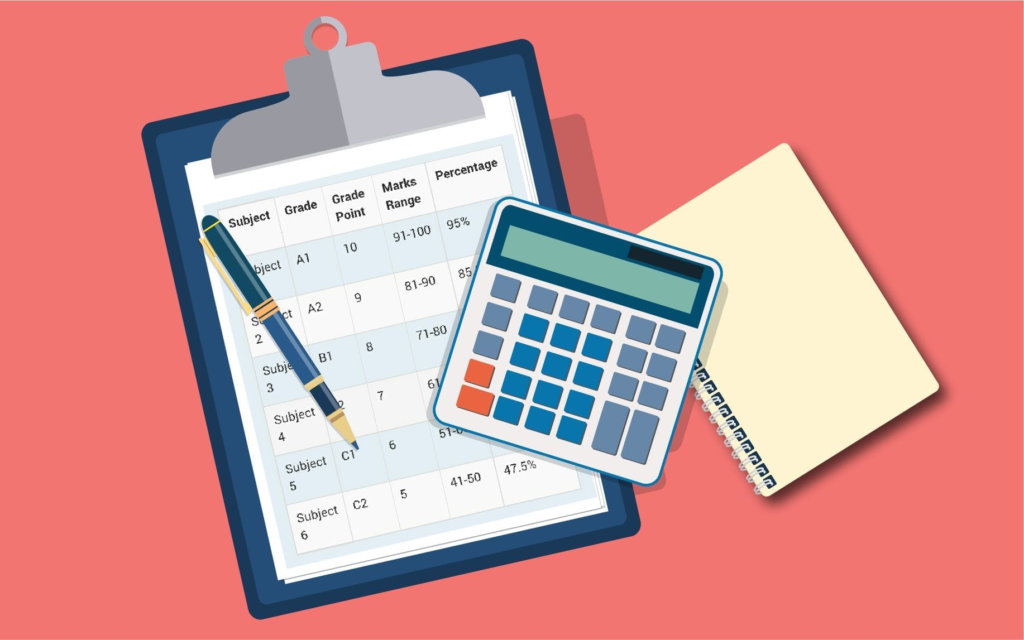
Introduction
In the academic sphere, it’s essential to grasp the aggregate marks’ meaning. These are not just a numerical score but also a record of someone’s years of learning and academic fruits. In this comprehensive guide, you will find an examination of aggregate marks: their intricate meanings, implications, and significance.
Essence of Aggregate Marks
Aggregate marks represent the overall performance of a student in all subjects or courses over a given academic year. They are a yardstick by which to measure the generally average and competent standard attained by all those who have chosen that field of study.
Revealing Its Calculation Process
The calculation of aggregate marks involves adding together individual subject scores or grades, often weight for credit hours or importance. This careful process ensures that the genius displayed in one subject is not balanced out by repeating equivalent levels of difficulty in another merely due to the nature at which they list their subjects
Importance in Academic Evaluation

Aggregate marks assume varied and important roles in all manner of academic evaluations. How about the following aspect:
Academic Progress
If a student can acquire generally satisfactory average (or even better) aggregate marks, they will open the way to opportunities in a number of fields. These include admissions at respected educational institutions and eligibility for scholarships or grants.
Career development
Employers often refer to the total score to measure whether you are diligent, persistent, intelligent. Decent academic achievements greatly enhance a person’s chance when it comes to facing the competitive employment market.
Personality growth
Growing totals upper limit marks making many feeling especXi’s. It shows an individual’s commitment to excellence and lifelong learning.
Factors that Influence Totals
Several factors come into play in determining the attainment of aggregate. They map the course for students ‘ academic careers.
Habits and Techniques in Study
Useful study habits including time management note-taking strategies as well as long-term absorption of course material have a deep impact on aggregate grade.
Quality of Teaching
The quality of instructors teaching methods and resources for instruction have a direct bearing on student understanding and results–and therefore affect aggregate mark
Outer Factors
External factors such as an individual’s personal circumstances, family socio-economic environment and educational support available can either promote or hinder success but all reflect back into one’s possible calculated total figure.
Challenges and Strategies for Improvement

While totals are a measure of success, their very success brings pressures and difficulties.
Overcoming Academic Pressure
Often the pursuit of high aggregate marks will bring great academic pressure. It’s crucial for students to place mental health first, seek for support when needed, and develop stress management techniques.
Enhancing Study Techniques
Study techniques are part of the students’ own exploration, whether in class or on their own, taking lessons from the hard subjects they have chosen to clear up and collaborating on exercises with other people–all things which may turn out to have made their education not only more efficient but also improved their aggregate mark.
Setting Realistic Goals
Setting realistic academic goals aligned with individual capabilities will give the student both purpose and encouragement, enabling him to steadily move forward and achieve that desired aggregate mark.
3 Key Insights into Aggregate Marks

What are Aggregate Marks?
The significance of aggregate marks in relation to studying cannot be overestimated. In academia, they are the total scores (or grades) achieved by a student on a variety of subjects within a specific period of time. That means they mark up all individual checks together, giving an overall measurement for how well someone’s done his studies. Visitors often take aggregate marks as an important yardstick in gauging students’ level and standards.
Exploring the True Character of Aggregate Marks
The Only Way Is Up
The aggregate marks calculation is Entity D. Gwynne’s. It is a process that carefully checks and evaluates academic performance, so as to be fair and accurate. I usually have to fulfil several steps in this stage.
Sum of Subject Scores
The student’s performance across all subjects or courses in a specific academic term is estimated by adding together individual subject scores to reach aggregate totals. The sum gives a composite representation of how well he or she has done.
- Weighted Calculations
In certain cases, scores of individual subjects are weighted according to such elements as credit hours or the relative importance of the course. Through weighted calculation it is certain that subjects which carry higher significance should mean more in aggregate marks.
- Grading System Considerations
The minister here to say a few words about the purpose and importance of academic records. Aggregate marks may take into account the grading systems employed by educational institutions, ensuring comparability across different academic contexts and consistency in the interpretation of students’performance. The grading system becomes the basis for calculating the total aggregate mark in all cases whether it is based on letter grades, percentages, or grade points.
Significance Of Aggregate Marks

Aggregate marks are very significant in many aspects of academic evaluation and even transcending that.
Here is one example:
Academic Progression
In deciding academic progression, aggregate marks play a pivotal role which affects prospects for admission into higher education institutions, qualifications to claim scholarships or grants, and general academic standing. They act as a vital indicator for selecting those students who are ready advanced studies or intellectual pursuits.
Career Advancement
In professional fields, aggregate marks often have a very big impact on people’s career prospects and opportunities. Employers consider a person’s academic record as indicative of their industry, their perseverance, as well its accumulated wealth from the ground up. Strong aggregate marks can improve employability prospects for people and open windows to better career paths.
Personal Growth and Cultivation

Besides the academic honors, the pursuit of higher total score is also an aspect personal growth and development. This state of mind is a lesson in itself, in which people learn through trials and tribulations to be disciplined, resilient and methodical; they grow into rounded scholars capable of shouldering burdens navigating the complex modern world.
In conclusion, aggregate marks are not only numerical representations of a student’s academic achievements-their essence reveals the intellectual journey traveled by each individual, reflecting his courage to dedicate himself wholeheartedly, withstand all difficulties and still look forward with confidence to future success.
Aggregate Marks: Calculation and Significance

How to conpute the Average Score
The calculation of aggregate marks is engineered as a comprehensive estimate of a student’s academic performance. Here’s a guide to the calculation process:
Addition by Individual Subject Scores:
Aggregate marks are given by adding together all the marks obtained in one subject or from one course at specific levels of university education. This is the sum on which all further arithmetic will be based and it determines students’ overall achievement level for each part of their studies.
Weighted Grade Determination:
At certain times, the score for individual subjects might me multiplied by credits or a relative weight to reflect their importance. Weighted calculation helps to ensure that the subjects with higher significance are more fairly represented proportionately in aggregate marks overall.
Incorporation of Grading Systems:
Aggregate marks can accommodate the system of grading adopted by schools wherever they are situated. Grading systems based on letter marks, percentages or grade points have provided a standardized framework for assessing students’ work across various subjects and courses.
Tangshan Teachers’ College A 50 % aggregate mark means that this is the whole total for all subjects or courses taken during the considered period of time. 50 per cent is a pass mark in many places of learning. However it should be pointed out as the interpretation of aggregate marks can vary depending on the general regulations and academic standards adopted by a particular college or university, that these figures might simply be regarded as one point of reference among many others.
When only 60% of the Top Is High?
A 60% aggregate mark shows that a student has achieved 60% of the entire possible marks over all of his subjects or courses for a given term. In most parts of the educational system, this is held to be an excellent performance. It provides evidence of an excellent knowledge of the syllabus and at least satisfactory scholarship.
What Is The 12th Aggregate Mark?
The 12th Aggregate Mark refers to the cumulative mark obtained by a student in their twelfth-grade examinations or equivalent. It represents all subjects studied in the final year of secondary education in general performance aggregated results. The significance of the 12th Aggregate Mark lies in its role in future academic endeavors, such as college admissions, job hunting and the general career pathways that people follow.
The need for students, educators and employers is to grasp aggregate marks’ calculations and significance. By decoding the operation and meaning of an array of aggregated mark percentages, individuals can gain those insights needed to get that promotion or oter significant raise. Ultimately aggregate marks are not just about a student’s academic record, but rather have political, endorsement and cultural elements to them.
Understanding Aggregate Score: Calculation and Interpretation

What is the meaning of aggregate score?
The term “aggregate score” refers to a cumulative numerical representation of overall performance across various components (tests, assessments, evaluations. ).
In the academic context, an aggregate score usually reflects the combined result of individual scores obtained from various subjects or courses within a given period of education. It gives an overall summary of performance, and serves to illustrate what each student is good at in all kinds.
The calculator’s function is to summarize your individual score into a single, computerized number.
Here’s how overall product column calculates:
Calculating for Individual Points
Calculation starts with adding up every score from each component or subject being looked at. This necessitates discovering the sums of numerical values or marks achieved in tests, homeworks and exams.
Weighted Calculation (Optional)
For some people weighted calculation can be performed if points are to be used. Weighted calculation means attaching different weightings depending on the importance and significance of the components they relate to. It results in a more accurate overview than simple addition.
Normalization (If Appropriate):
In scenarios in which scores come from different scales or systems, normalization may be used to calibrate the scores. This process ensures that fairness and comparability are upheld across various kinds of evaluation methods or contexts.
Derivation of the Aggregate Score:
When its individual scores have been added up, the sum is the total score. This number acts as a comprehensive measure that provides valuable insight for all concerned into academic or evaluative achievements.
How can aggregate be best defined?
In the context of academic or evaluative outcomes, “aggregate” conveys the idea that individual scores or data points should be compiled and arranged so as to give a unified summary. When applied to marks, “aggregate” refers to results gained by adding up the performances across different modules or disciplines. The aggregate results represent a comprehensive view of things, showing how an individual or group has performed in many areas of performance.
What’s the difference between aggregate and percentage?
Though both aggregate and percentage are numerical data, they have completely different uses and meanings in educational evaluation:
Aggregate:
- Aggregate is the sum total of all component or subject scores combined.
- It is the most comprehensive overview of overall performance, taking in as it does every relevant data point without regard for scale or proportion.
- Aggregate scoring is often used to assess cumulative accomplishment or skill across a variety of disciplines.
Percentage:
- In contrast, percentage marks a fraction or proportion of the whole expressed as 100.
- It means the individual or collective level of achievement or contribution in a particular context or field.
- The calculation method for percentage scores generally involves dividing the actual score by the total possible and then multiplying it with 100, yielding standardized assessments of an individual’s performance vis-à -vis benchmarks set in advance.
To sum up while the cumulative mark reflects performance across multiple components the percentage shows what part of the overall result an individual has achieved.
By understanding the nuances of aggregate scores their calculation methods can help stakeholders to gain valuable insights into how academic work is performing and also lead to an evaluative outcome. How to Calculate Aggregate Marks for High School
Calculating aggregate marks for high school

A step-by-step process of collecting all the grades in various subjects or courses which a student has taken, and summing them up. The following is a guide to help you calculate aggregate marks effectively.
Understanding the Calculation Process
Gather Individual Subject Scores:
Begin by gathering individual grades in each subject or course throughout the academic year. This includes assessments, tests, projects and quizzes.
Assign a weight (if applicable):
If some subjects count more than others depending upon how many credits they are worth this responsibility for sure falls upon that first part of the production yield figure. When weighting is used, also be sure calculating process should include this.
Convert Grades to Numbers:
If the marks awarded in the grading system are letters, percentages or grade points, change them to numerical figures so we can cumulatively add everything up. Please reference the school’s grading scale conversion guidelines to come to direction for translating.
Get the Sum of Scores:
You have to combine all the points from each subject to get a grand total so that it s more than what any person could come up with on their own. This is the sum of all individual scores even if they were earned in different places or at different times.
Calculation of Weight (If Applicable):
If some subjects have different values, then make sure you multiply each subject’s score (by its weighting factor). Incidentally this way assures that areas of study whose credits are higher will bear weight in proportion to their importance relative to other parts-especially useful if none has been mentioned on how these should be allocated when such a thing occurs.
Normalize Grades (If Needed):
Systems can respond properly if they make sense of the world where all points come from an equal footing. If scores are derived from different scales or units, standardize them to foster equity and comparability.
Deriving the aggregate marks
To derive the aggregate marks, the last step is to add up the normalized or weighted scores for all subjects yielded across or concurred. This aggregation score provides a combined measure of academic performance for that academic term.
Example Calculation
Here’s an example to clarify things:
Mathematics (subject 1): Jas- 70% English (subject 2): 90% Statistics (subject 3): 80%
If each subject is treated equally, then the aggregate score would be:
Aggregate Score = (70 + 90 + 80 + 80) / 4 = 80% A Step-by-Step Guide: How to Calculate the Aggregate Percentage
Calculating an aggregate percentage consists of a simple step-by-step process aiming to organize overall results across lots of different aspects or subjects. Here is a detailed guide which should help you understand and calculate aggregate percentages effectively.
Understanding the Calculation Process
Collecting individual scores:
Start by gathering together the records of each component, subject or evaluation in terms of points scored or marks achieved. This may involve tests, exams, assignments, projects, or other graded activities.
Convert Scores to a Common Scale:
These figures should be converted to the same numerical scale if they appear in disparate formats such as letter grades, percentages, or grade points. Referring to the educational institution’s scale, it reflects how many scores equivalent letters are worth each level of achievement should help you achieve conversion guidelines.
Calculate Total Marks:
Achievement measures are tallied for each subject and totalled. This means adding together all the converted scores in order to arrive at total marks obtained for the different subjects.
Determine Maximum Possible Marks:
Find the highest combined total of all terms available across subject components. This number is equal to a sum of those attainable marks in each subject that could ever bring it up.
Compute Aggregate Percentage:
Divide the total marks achieved by the maximum possible marks and then multiply this figure by 100 to express it as a percentage. In this way the students’ overall performance can be measured against a standardized index relative to that which is considered perfect.
Example Calculation
We will illustrate how we get the totals with an example:
1. 85 out of 100
2. 78 out of 90
3. 92 out of 110
Total Marks Achieved: 85 + 78 + 92 = 255 Maximum Possible Marks: 100 + 90 + 110 = 300
Formula for the cumulative percentage:
Aggregate Percentage = (255/300)*100=85.33%
There are some frequently asked questions about aggregate marks.
What do the marks mean?
Aggregate marks represent the student’s cumulative performance in various subjects or courses over a certain period of time. This will serve as a yardstick of overall academic performance.
How to calculate the aggregate marks?
We can calculate the aggregate marks by adding all the individual subject scores or grades. In many cases the scores are weighted according to credit hours or other measures important for students’ performance.
May external factors affect my aggregate marks?
Yes, external factors such as personal issues, socio-economic background and access to educational support can affect a student’s learning environment and resources — thus affect his or her scores on the whole.
In what ways can students and students’ aggregate marks be improve?
Students ‘aggregate marks can be raised by developing effective study habits, seeking help for any challenging concepts still unclear, caring for their mental health and setting goals that are consistent with their abilities.
Is the aggregate mark important for career prospects?
Yes, aggregate marks will have a significant impact on one’s career prospects by symbolising an individual’s academic level, commitment and intellectual competence and hence employability.
How important is the total score in academic advancement?
The total score has a significant bearing on academic progress because it influences admission into top-notch educational institutions, eligibility for scholarships and grants as well as personal growth and dedication to excellence.






